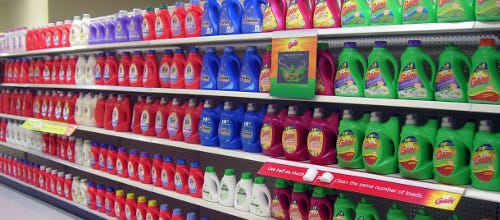Fiercely focused
VISIONARY: Wal-Mart Stores Inc.
If you were one of the 500-plus people at the keynote address at Pack Expo Intl. 2006 when Wal-Mart Stores Inc. unveiled its Packaging Scorecard, it's likely it was an event you won't forget. The reverberations of that announcement are still being felt in the packaging industry—nearly seven years later.
The mega-retailer and private-label powerhouse continues to move the needle in sustainability, as well as in cost savings, supply chain efficiencies and shelf impact.

Ron Sasine
Ron Sasine, Wal-Mart Stores' senior director of packaging, private brands, tells Packaging Digest what challenges he sees for the future and how the company will continue to lead.
Q: What is the most pressing problem in packaging today and why?
A: The biggest opportunity we face in packaging today is cutting through the clutter. Every aisle is filled with new products, new flavors and new formats. It's great fun for designers and packagers, but it can be challenging for consumers to navigate the new offerings. Many brands face an uphill battle getting off the shelf and into the basket.
Q: What consumer trend(s) will have the most impact on how products are packaged in the future and why?
A: Just as the transition from small, local retailers to national chain stores changed the way packaging interacted with products, advertising and consumer habits, growth in e-commerce presents a real possibility for completely new ways to brand, package and distribute products.
Q: What has been one of the most remarkable recent advancements in packaging and how has it benefitted the industry?
A: I'm carefully watching the advent of extended gamut printing, which could offer significant cost savings, simplified pressroom management and greater changeover efficiency. Within a few years we will wonder how we ever survived without 7-color presses.
Q: What advice do you have for the next generation of packaging pros?
A: The next generation of packaging professionals will need marketing abilities that match their technical skills. We no longer live in a world where engineers and marketers can work in their own separate cubicles and loft projects over the wall at each other. At Wal-Mart, we've adopted a fully cross-functional approach that brings Marketing, Product Development, Quality and Supply Chain to the same table. Each member of the team contributes his or her expertise and shares in the project's success or failure.
Q: How do you motivate your team in packaging R&D/operations/design/QA/logistics?
A: Motivation is real easy at Wal-Mart: We're here to save people money so they can live better. We don't ever wonder about what we're trying to accomplish with a given packaging project. Every plan is influenced by that shared desire to reduce the cost of living for our customers.
Forging ahead
Packaging-related initiatives at Wal-Mart Stores Inc. (which includes Walmart, Sam's Club, ASDA stores in the U.K. and many others around the world) vary from sustainability scorecards, traceability and concentrated products to front-of-pack nutrition icons, electronic product codes and more.
2004 - Wal-Mart and eight product manufacturers conduct a trial of electronic product codes (EPCs) embedded in radio frequency identification tags on cases and pallets at select Supercenters and one regional distribution center in the Dallas/Fort Worth metroplex.
2005 - The retailer develops a case-ready meat program for its Supercenters and Neighborhood Markets. The pre-packed meat provides shoppers with selections that have enhanced quality control, leak-proof packaging, better overall appearance and better product tracking.
2006 - ASDA launches its "Zero Waste to Landfill" target. By 2010, everything the supermarket disposes of at the back of its 307 food stores will be recycled, reused or composted instead of being sent to landfill.
Wal-Mart Stores launches its Sustainable Packaging Expo, inviting select packaging suppliers to show their sustainable solutions to the retailer's buyers and key vendors.
At the end of the Clinton Global Initiative in September, Wal-Mart launches its five-year plan to reduce packaging. Scheduled to start in 2008, the initiative is projected to cut overall packaging by 5 percent.
As part of that plan, Wal-Mart introduces its Packaging Scorecard to a standing-room-only audience during a keynote address at Pack Expo Intl. This measurement tool allows its buyers to evaluate vendors based on specific metrics evolved from favorable attributes known as the "7 R's of Packaging": Remove, Reduce, Reuse, Recycle, Renew, Revenue and Read.
In November, Wal-Mart Stores accelerates the national roll-out of its $4 generic prescription program, which kicked off in September in Florida. The medicines are offered in user-friendly blister packs that contain individual periodic doses of medications, along with details and easy-to-understand instructions for consumers.

Walmart concentrated
2007 - At the Clinton Global Initiative, Lee Scott, president/CEO of Wal-Mart Stores, announces plans to sell only concentrated products in the liquid laundry detergent category in its U.S. Walmart stores and Sam's Clubs (lower left photo). The commitment is expected to save more than 400 million gallons of water, more than 95 million pounds of plastic resin and more than 125 million pounds of corrugated board.
2010 - Wal-Mart announces its responsible purchase policy for fishes and traceability program for perishable products. The "Selected Quality, Guaranteed Origin" program allows consumers to track the origin and path of produce through the bar code on packages.
2012 - Wal-Mart unveils its "Great For You" icon, which appears on hundreds of food items to provide a simple way for consumers to make healthier food choices.
In fall 2012, Wal-Mart announces it will expand its use of compliance packaging in Walmart and Sam's Club pharmacies. The new unit-dose packaging (pictured at left) begins shipping to store pharmacies in early 2013. It offers large, easy-to-read type on all sides and clear, simple opening instructions. It's also stackable, easy to carry and child resistant. And, once the carton is opened, the integral blister pack offers easier-than-usual push-through pill access.
2013 - Working with its suppliers, vendors and other key stakeholders, Wal-Mart meets its goal to reduce packaging by 5 percent. The retailer has reduced the overall greenhouse gas impact of its packaging by an average of 9.8 percent in Walmart stores in the U.S., by 9.1 percent in Sam's Clubs in the U.S. and by 16 percent in Walmart stores in Canada.
.
About the Author(s)
You May Also Like




